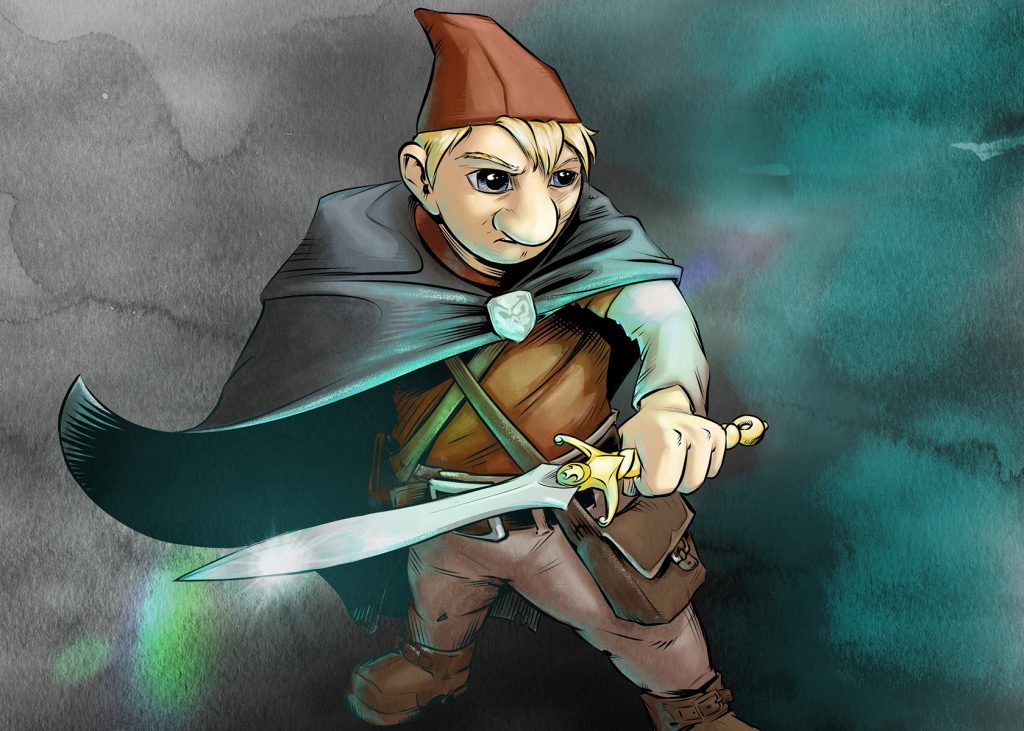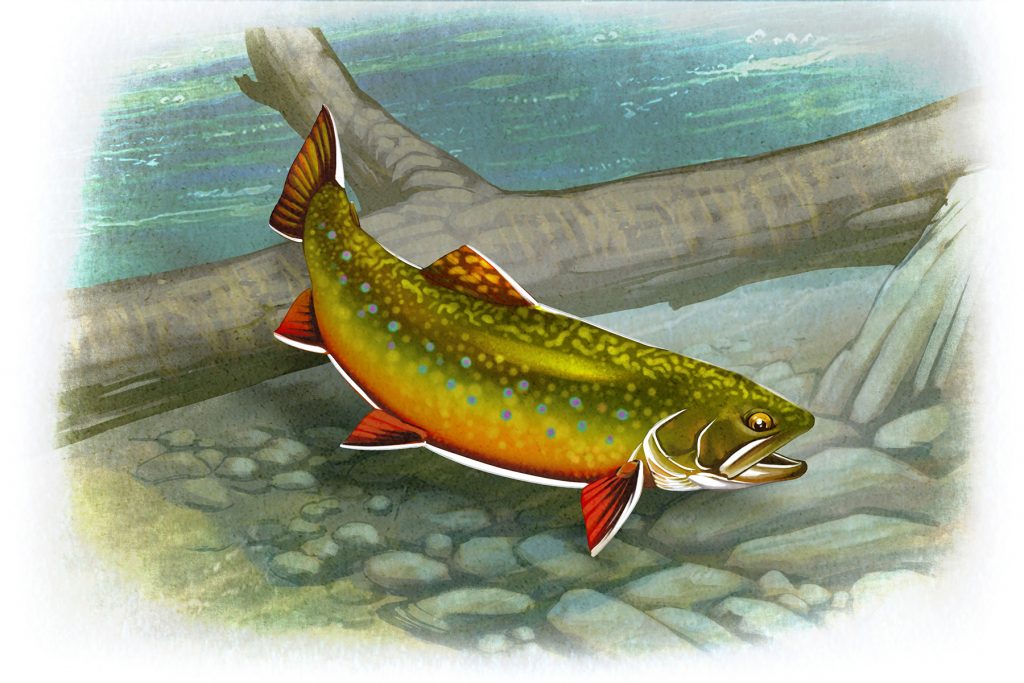Surrounded by beautiful forests in a town called Murphysboro you will find Daryl. He is a board game artist that broke into the industry with a personal passion project – The Dobbers. With his recent wonderful contribution to the game Freshwater Fly ( Only a few hours left on the Kickstarter) – I knew that we had to pick his brain and feature him here. Enjoy.

Tell us a little about what you do, your artistic background and how you got into making art and now board games?
I’ve been drawing as long as I can remember. My passion to draw really ignited in the late 80’s and 90’s when I fell in love with Marvel comic books. I have a full set of the original Infinity Gauntlet comics sitting on my desk with me as I type this. I later went to the Savannah College of Art and Design in Georgia, majoring in Sequential Art. Sequential Art is basically comic books. There is a heavy emphasis on Illustration and Graphic Design, particularly for the purpose of story-telling. After college, I independently published a comic book, The Dobbers. It was a light-hearted tale of gnome-like, forest creatures who stumble upon a quest involving a great deal of treasure and a magical sword.


After many years, happily working as a designer and illustrator, I found myself wistfully looking back at my comic. I wanted to draw and create in that cute and clever world again. I wanted to tell the story of the Dobbers to more than just my friends and family.

In addition to comics, I grew up with a passion for games, particularly board games and role-playing games, which never died. My wife is a gamer and my kids are gamers. It only seems natural that the Dobbers should come to life as a board game!

The rest, as they say, is history. Once I successfully Kickstarted Dobbers: Quest for the Key, I was hooked and getting requests from other publishers to do art for their games. I love what board games and table-top RPGs do for people, connections, relationships, creativity, joy, competition, everything you need to have a thriving community. I’m privileged to be working in such a rewarding career.
You can find more of my work in other nerdy worlds such as, True Dungeon, Dwarven Forge, Nerd Fitness, Green Couch Games, Nerdarchy and Bellwether Games.
We also wanted the colors to provide visual cues to game play. For example, green bordered fish are easy to catch and gold bordered fish are the greatest prize and thus, harder to catch.
You are the artist and graphic designer on the new game Freshwater Fly by Bellwethergames. The art really feels like it captures the atmosphere of fishing. How did you and the designer decide how everything should look?
It’s great working with Dennis at Bellwether Games. He had a great vision for the product he wanted to produce and of course, Brian Suhre created a great game, which made way it easier. After working through the box illustration, logo and fish illustrations, we worked on colors and icons. It was important, if possible, to use a color spectrum that was color-blind friendly. It’s not perfect, but I think we provided a strong solution. We also wanted the colors to provide visual cues to game play. For example, green bordered fish are easy to catch and gold bordered fish are the greatest prize and thus, harder to catch. One of the next challenges was to create icons that allow the game to be mostly language independent. I have to give most of the credit there to Dennis and Brian. They created the icons for the prototype, I just had to refine and make them visually cohesive with the art style for the game.



A lot of other elements were inspired by my experience fishing.
Where did you start – illustrations or graphic design?

I began with the box illustration and logo. This helped to set the tone for everything. I then focused on the fish and fly illustrations. Once these elements were complete, I had a foundation for all of the graphic design. It flowed pretty easily from there.
Personally, I learned I should plan more time for the rule book. Hah, I seem to have a tendency to underestimate the time it takes.
Was there anything you learned from working on Freshwater Fly that you want to share?
Personally, I learned I should plan more time for the rule book. Hah, I seem to have a tendency to underestimate the time it takes. A proper rule book has icons and graphics that visually illustrate how to play the game in addition to the text. Not news, to be sure, but I think it’s easy to overlook those elements when you’re in the planning phase of the project.

Additionally, after working with Dennis, I learned a lot about early prototyping stages of game development. In my first game, I started with art, before the game mechanics were final. Sure, I’m an artist, it’s somewhat natural that I’d focus on art. But I really like Dennis’s “art-free” version of Freshwater Fly. As a fellow game designer I learned a lot about how valuable it is to take a game to near completion even if the art and icons aren’t final yet. It makes your understanding of what is needed and how players use the components much more thorough.
I’m by the way absolutely in love the fish cards. Can you tell us about the creative steps you go through when making a piece of art for the game from idea to final art?

It all starts with research. Looking at photos of fish on the internet and checking out books from the library. For this particular subject, I had a little more luck with library books, but I still used Pinterest a lot. Once I found the information I need I sketched the fish finding a pose and honing in on the details that made each fish unique. I use Clip Studio Paint for most of my drawing, inking and the flat colors. I wanted to fish to have a unique and easily identifiable image.


After completing all the sketches, I sent proofs to Dennis at Bellwether to make sure I was heading in the right direction. He approved them then I was back to drawing. I refined the drawing, clarifying any remaining details and defining a light source. I laid in flat colors for the fish and background. Then created an overlay layer to create light, shadow and form. The illustration looks something like a cartoon now.

Next I pull the illustration into Photoshop to add texture and a paint layer or two. This is where the illustration really comes to life. I add lighting effect, scales, small details like scales and elements of the eyes. After another round of proofing, I finalize the image by flattening it to be used in Indesign where I will assemble the cards.
What are your preferred tools (software/hardware/traditional) – tell us about your workplace?
I have a small office outside of my home. It’s got all my goodies and equipment. It’s my working man-cave, of sorts. 🙂
I use a Surface Studio for most of my illustration work. It’s an amazing drawing tool and I’m very fortunate to have it. As mentioned earlier, I work mostly in Clip Studio Paint for illustration, but I also do a ton with Photoshop, Illustrator and Indesign for other aspects of each project.
How do you manage time between game designing and art creation?
It’s not easy. Being an artist at heart, there are times when my passion or inspiration dictate where I should focus. If I don’t roll with my inspiration when it hits, I don’t typically do my best work. That being said, I have to meet deadlines. It can lead to an occasion very late night. For day to day tasks, I try to maintain a running list of outstanding items that need to be done.
What has been the biggest challenge working on Freshwater Fly?
The board, I feel came out very nice, but as you can see, there is a lot going on. We had a ton of information to communicate but wanted to maintain imagery that evoked the beauty of nature. The challenge was finding the right balance between illustration and graphic design.

Name up to 3 artists you admire?
There are so many amazing artist throughout history and across disciplines! I’ve been studying art since the 90’s so I could provide an overwhelmingly long list. For now, let’s just pick three, each from a different era and area of focus.
Wassily Kandinsky was a pioneer of abstract art and expression. His work was largely driven by his faith, a quality that has me coming back to admire his art time and time again.
Frank Frazetta was a fantasy and sci-fi artist. He was one of the first who sought to elevate what many viewed as a lesser art form to premier level. He was a pioneer whose work helped pave the way for future fantasy artists such as myself.
There are a ton of modern board game artist doing amazing work today and I hesitate to name just one, but I will, you’ve probably heard of him, Vincent Dutrait. I love the creativity and imagination he wields. His style has some of the whimsy I hope to convey, but still feels grounded in classical fundamentals.
What is your current source of inspiration?
Comic books, movies, other board games, pinterest.
I know you are working on some new releases – is there anything you can share with us. I think the cover for Always Green Garden look very intriguing.

The Alwaysgreen Garden is set in the same world as the Dobbers. However this is an entirely different game. It’s a casual, light game with a unique mix of worker placement, tableau and resource management.
Magical animal gardeners work with you in their enchanted garden as you create the best menu of unique forest dishes competing to become the new head chef of the Acorn Inn.
The game features a dynamic play area that changes with each player interaction. Your goal is to harvest ingredients and work with the magical animal gardeners to make the most fantastic table of recipes!
I’ll have prototype copies at Geekway to the West in May with the Kickstarter launching in June spanning the time I’m at Origins.
Finally – where can people find more about you?
Web – splatteredink.com
Instagram – instagram.com/splatteredink
Twitter – twitter.com/splatteredink
Facebook – facebook.com/splatteredink

